Easy Mango purée
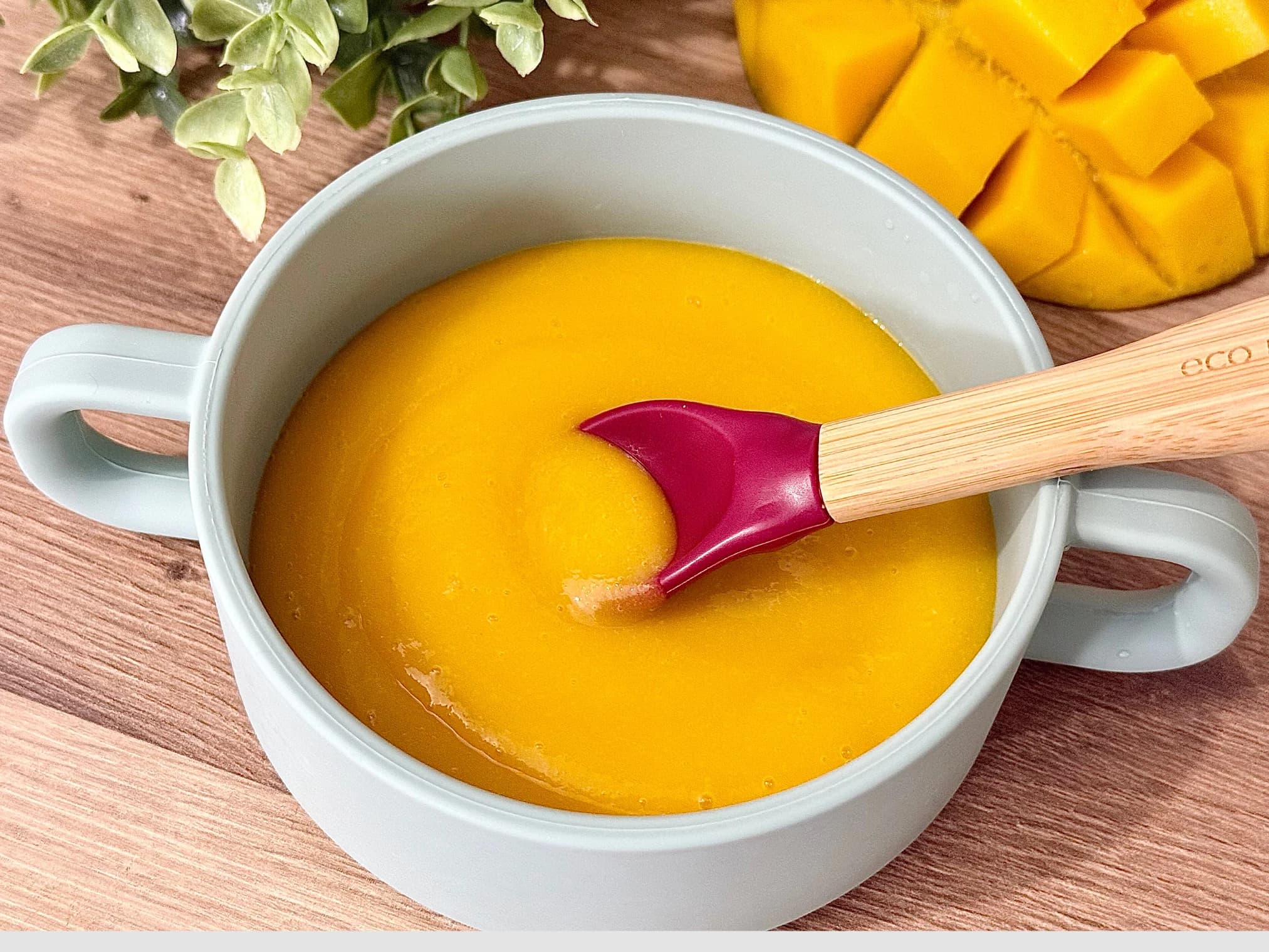
Written by Kenny Ekerin
Fact Checked by Mindsmaking Professionals
1st, December, 2025
This post may contain affiliate links. Please read our disclosure policy.
Looking for a nutritious first food for your baby? Try this easy mango purée recipe—naturally sweet, vitamin-packed, and perfect for introducing solids. Quick to make, versatile, and great for boosting immunity and digestion.
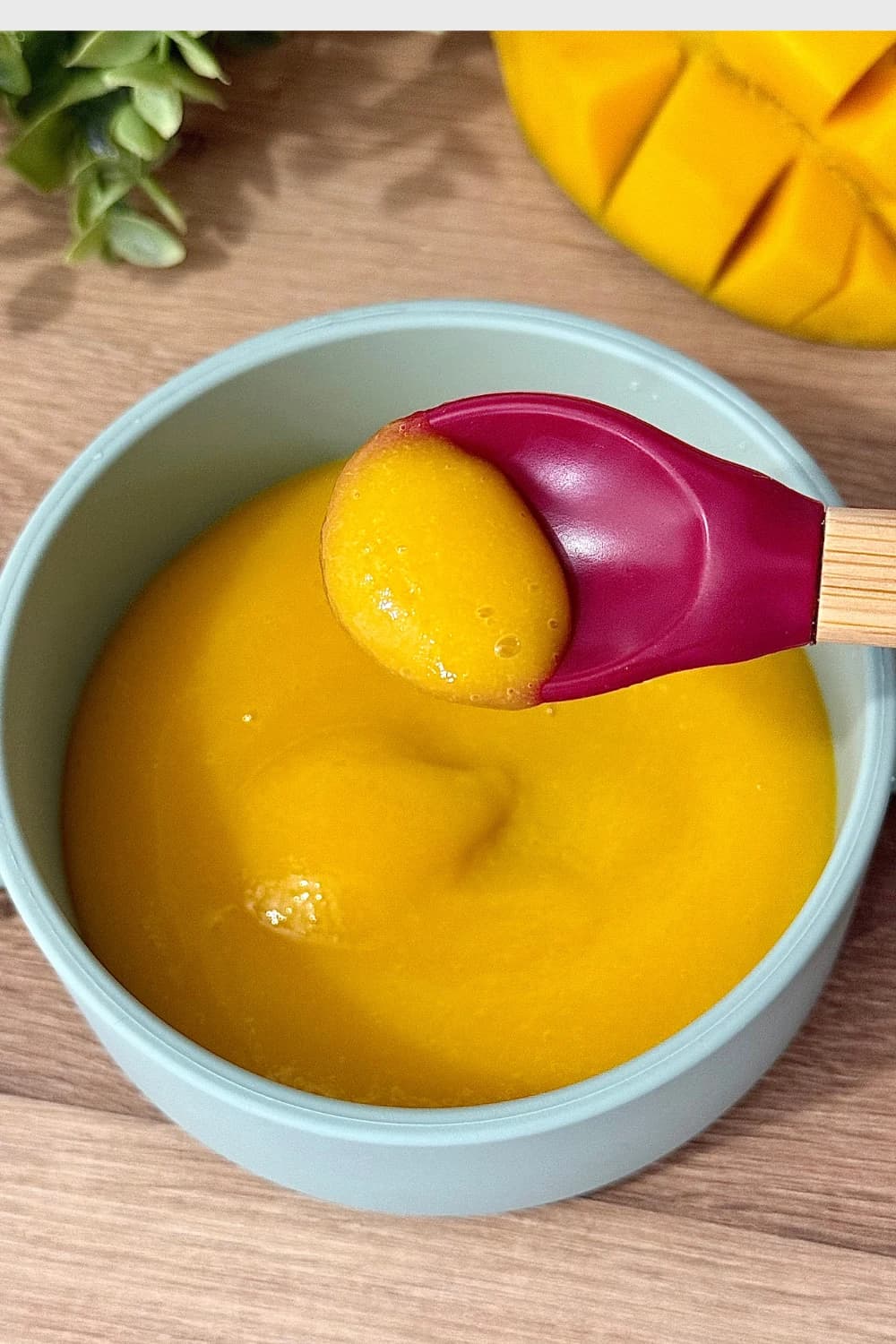
Why this Mango Purée is Great for Babies
First and foremost, mangoes are packed with essential nutrients. They are an excellent source of vitamin C, which supports your baby’s immune system, and vitamin A, which is important for eye health and growth. Mangoes also contain fiber, which can help digestion and promote healthy bowel movements in babies.
Another reason to love mango purée is its natural sweetness. This makes it an appealing first food for babies just starting solids, as the taste is gentle and not too overwhelming. The sweet, rich flavor of mango can also make it easier to introduce other fruits or vegetables by mixing them with mango for a more enjoyable experience.
Mango purée is also easy to prepare. All you need is a ripe mango or some thawed frozen mango chunks, and you’re ready to blend them into a smooth, delicious purée. This simplicity makes it a convenient option for busy parents who want to provide their baby with homemade, nutritious food without spending much time in the kitchen.
Additionally, mango purée is versatile. You can mix it with other fruits like bananas, apples, or pears, as well as with vegetables or yogurt to create different flavors and textures as your baby’s palate develops. You can also use it in various meal contexts—whether on its own, in cereal, or as a topping for other dishes.
Lastly, mango purée is a great way to introduce new textures and flavors to your baby. As your baby grows, you can adjust the consistency, allowing them to explore both smooth and slightly chunkier versions. This can help develop their ability to handle more complex foods and encourage a lifelong love of healthy eating.
Easy Mango Purée Recipe
Ingredients
- 2 cups of fresh or frozen mango (If using frozen mango, be sure to thaw it)
- Water, breastmilk, or formula (optional, to thin the purée if needed)
Mindsmaking
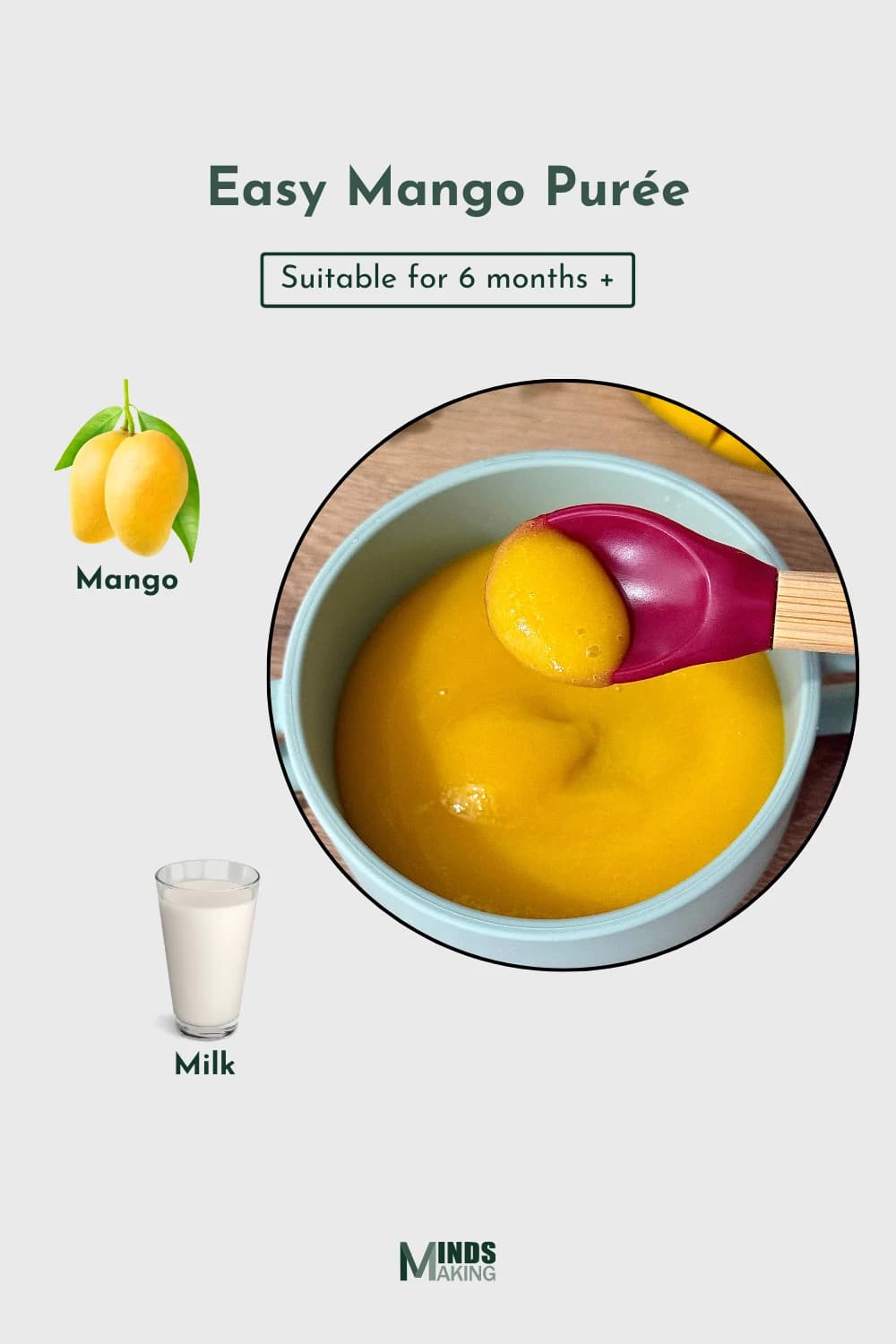
Instructions
1. Prepare the Mango: If using fresh mango, peel the skin, remove the pit, and chop the mango flesh into small pieces. If using frozen mango, allow it to thaw at room temperature for about 15-20 minutes, or you can also thaw it in the microwave for a few seconds. Once thawed, it will be easier to blend.
Mindsmaking
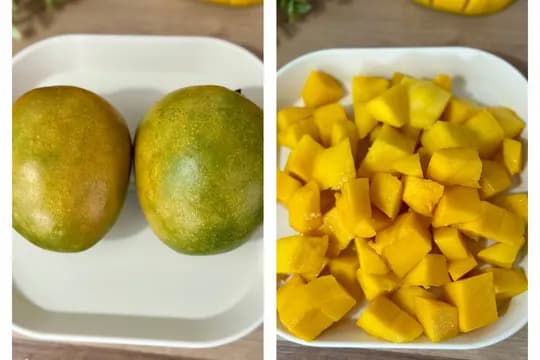
2. Blending the Mango: Place the chopped mango (either fresh or thawed frozen mango) into a blender or food processor. Start blending at a low speed, gradually increasing to a higher speed to achieve a smooth texture.
Mindsmaking

3. Adjust Consistency: Once the mango is blended, check the consistency. If the purée is too thick for your baby’s liking or ability to eat, you can thin it out. To do so, gradually add water, breastmilk, or formula (whichever you’re using) a little at a time, blending between each addition until the purée reaches a smooth and easily spoonable consistency.
4. Serve or Store: Once your mango purée is ready, it can be served right away or stored for later use. To serve immediately, simply spoon the purée into a bowl and offer it to your baby.
Read This Next

Recipe Ebook
Essential Guide to Starting Solids for Babies 6 Months+ - LBH Top 70 Baby Puree & Porridge Recipes eBook.
Start your baby’s solids journey with confidence using this "70 Baby Purees & Porridges" eBook! Created with care, this digital guide is packed with nutrient-rich recipes for babies 6 months and older, including purees and porridges tailored to each stage of your baby’s development.
Mindsmaking

Tips for Success
Choose the Right Mango: Select ripe mangoes that are slightly soft when pressed. Overripe or underripe mangoes may affect the taste and texture of the purée. For frozen mango, choose high-quality frozen mango chunks that contain only pure fruit without added sugars or preservatives. Ripe mangoes offer the best natural sweetness and smooth consistency for the purée.
Adjust the Texture Based on Your Baby's Age: For younger babies (around 6 months), it's best to make the purée very smooth and thin, using breastmilk, formula, or water to help achieve the right consistency. As your baby grows (around 7-9 months), you can leave the purée slightly thicker or chunkier to allow them to explore different textures and develop their chewing skills. Always adjust the consistency to suit your baby's ability to handle it.
Avoid Sweeteners: Mangoes are naturally sweet, so there’s no need to add any sugar, honey, or artificial sweeteners. For babies under 1 year old, avoid honey due to the risk of botulism. Keeping the mango purée pure and free of added sweeteners ensures it's a healthy option for your baby.
Freeze for Convenience: If you make a larger batch of mango purée, consider freezing it in small portions using ice cube trays or baby food trays. Once frozen, transfer the purée cubes to a freezer-safe bag or container. This makes it easy to thaw just the amount you need, and it reduces waste. It’s also a convenient way to prepare baby food in advance.
Keep the Serving Temperature Comfortable: Before feeding your baby, check the temperature of the purée. It should be at room temperature or slightly warm, but not too hot, to ensure that it’s safe and comfortable for your baby to eat. Heating it too much can cause discomfort or burns, so always test it first.
Serving Suggestions
When serving mango purée to your baby, there are a few ways to get creative and make mealtime more enjoyable. One of the simplest ways is to serve it on its own as a single-ingredient meal. Freshly made mango purée is naturally sweet and full of vitamins, making it an excellent first food for babies. You can offer it in a small bowl or spoon-feed it to your baby. If you're starting solids, this will be an ideal choice for introducing fruit.
For babies who are a bit older and ready for more textures, you can mix the mango purée with other pureed fruits or vegetables. For instance, blending mango with avocado (avocado mango purée) can provide a creamy texture and a boost of healthy fats. You could also combine it with pear (avocado pear puree), apple (apple and avocado purée), or banana for variety and additional nutrients. This gives your baby a mix of flavors while still keeping it easy to digest.
Another fun serving suggestion is to add mango purée to breakfast items. For babies who are eating cereals or porridge, you can stir a spoonful of mango purée into their oatmeal cereal or rice cereal to sweeten the meal naturally. This also introduces a new flavor without overwhelming the taste buds.
If your baby is ready for finger foods or exploring new textures, you can freeze mango purée into small cubes and use it as a chilled snack. The cool texture is perfect for teething babies. You can also freeze the purée into popsicle molds for a refreshing treat.
For a more exciting option, try mixing mango purée with yogurt (mango yogurt) for a creamy, tangy twist. This combination can help introduce your baby to new flavors and textures, and the yogurt adds extra calcium and probiotics.
No matter how you serve it, make sure to always adjust the texture of the purée to your baby's stage of eating. The purée can be smooth for younger babies or slightly chunkier for those with more advanced eating skills.
How to Store
To store your mango purée, it’s important to follow proper guidelines to maintain its freshness and nutritional value. If you plan to serve it within a few days, you can store the purée in the refrigerator. Place the mango purée in an airtight container and store it in the fridge for up to 3 days. This helps prevent spoilage and keeps the purée safe for your baby.
For longer storage, freezing mango purée is an excellent option. You can pour the purée into ice cube trays or baby food trays, which allows you to freeze it in small, manageable portions. Once the purée is frozen solid, transfer the cubes or portions into a freezer-safe bag or container. Be sure to label and date the container so you know when it was made. Frozen mango purée can last for up to 3 months in the freezer.
When you're ready to use the frozen mango purée, you can thaw it in the refrigerator overnight or use a warm water bath to thaw it quickly. Avoid microwaving the purée directly in a bottle or jar, as it can heat unevenly and create hot spots. Once thawed, do not refreeze the purée, and any leftovers should be discarded after 24 hours.
Nutrition
Suitable for 6 months +
NUTRITION GUIDE (Per 1/4 cup serving)
- CALORIES: 24KCAL
- CARBOHYDRATES: 6G
- PROTEIN: 0.3G
- FAT: 0.1G
- SODIUM: 1MG
- POTASSIUM: 180MG
- FIBER: 1.4G
- SUGAR: 5G
- VITAMIN A: 1121IU
- VITAMIN C: 30MG
- CALCIUM: 10MG
- IRON: 0.2MG
Note: Nutritional values are estimates and may vary based on ingredient brands and portion sizes.
Frequently Asked Questions
When can I start giving mango purée to my baby?
Mango purée can be introduced to babies around 6 months of age, once they've started solids and show readiness signs like sitting up with support and good head control.
Is mango safe for babies?
Yes! Mango is a nutrient-rich fruit that’s safe and healthy for babies. It’s naturally sweet, easy to digest, and packed with vitamins A and C, plus fiber to support digestion.
Do I need to cook the mango before puréeing?
No cooking is needed. Ripe mangoes are soft enough to purée raw, and cooking is unnecessary. Just peel, pit, and blend!
Can I use frozen mango instead of fresh?
Absolutely! Just make sure to thaw the frozen mango fully before blending, and choose a variety that’s free from added sugars or preservatives.
What kind of mango is best for baby food?
Look for ripe, sweet mangoes like Ataulfo (honey mango) or Kent, which have a creamy texture and mild flavor. A ripe mango will yield slightly to pressure and have a fruity aroma.
Should I add anything to the purée?
You don’t need to add anything, but if the purée is too thick, you can thin it with breast milk, formula, or water. Avoid adding sweeteners, salt, or honey.
Can I mix mango purée with other foods?
Yes! Mango pairs well with banana, avocado, yogurt, oatmeal, apple, pear, and more. Mixing it can introduce your baby to new flavor combinations and textures.
How long can I store mango purée?
Fridge: Up to 3 days in an airtight container Freezer: Up to 3 months in a freezer-safe container or baby food tray
How do I thaw frozen mango purée?
Thaw it overnight in the fridge or use a warm water bath. Avoid microwaving in a sealed container to prevent uneven heating.
Can I freeze mango purée in jars?
You can, but use freezer-safe jars and leave enough space at the top for expansion. Ice cube trays or silicone baby food molds are ideal for portioning.
Can I serve mango purée cold?
Yes! Just make sure it’s not too cold—room temperature or slightly chilled is best. For teething babies, chilled mango purée cubes can also be soothing.
Can I serve mango purée with baby cereal?
Definitely! Stirring mango purée into oatmeal, rice cereal, or quinoa cereal is a great way to add natural sweetness and boost nutrition.
What if my baby doesn’t like mango purée?
No worries! Taste preferences develop over time. Try mixing mango with another favorite food like banana or apple, and offer it again after a few days.
Was this article helpful?
How many stars are you giving this article?
Leave a comment
Your email address will not be published.
Comments
More From Recipe
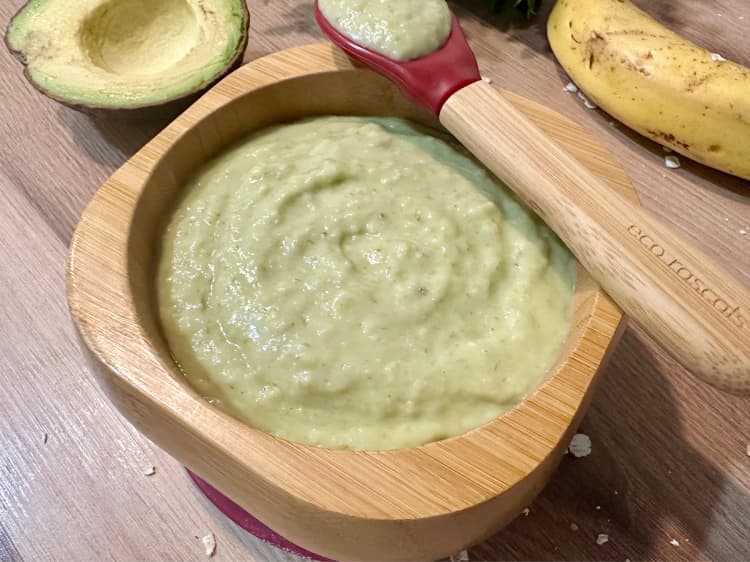
Avo Banana Oats Porridge
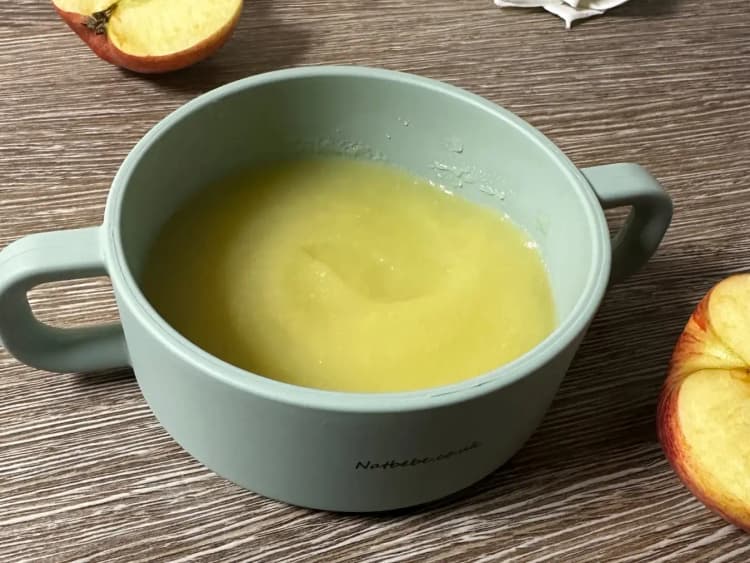
Apple Puree
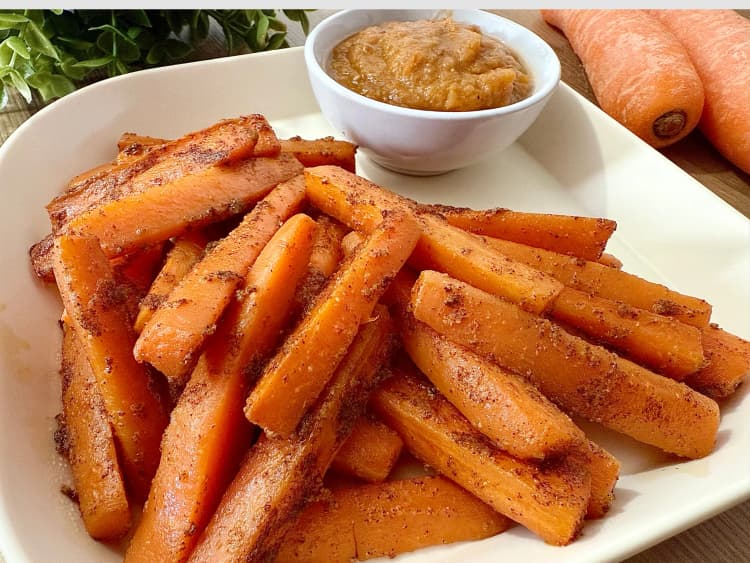
Carrot sticks

Sweet Potato Corn Puree

Easy Greek Yoghurt Banana Pancakes
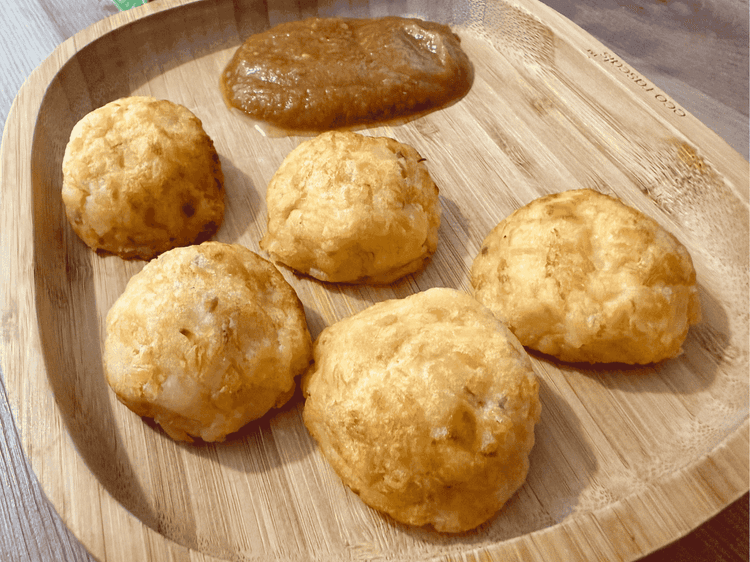
Salmon Fish Cakes
Get new recipes to your inbox
Subscribe to our weekly newsletter and get new recipes sent to your inbox!